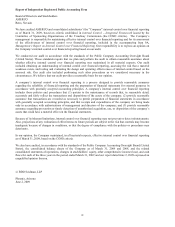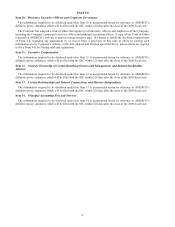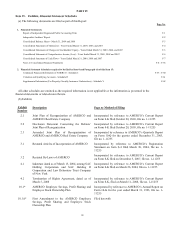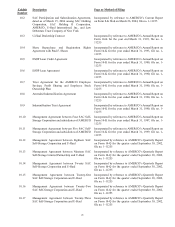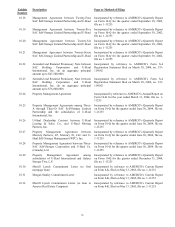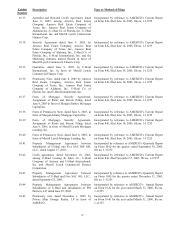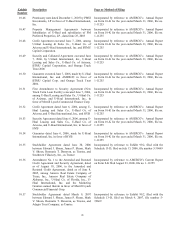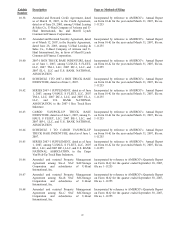U-Haul 2009 Annual Report Download - page 56
Download and view the complete annual report
Please find page 56 of the 2009 U-Haul annual report below. You can navigate through the pages in the report by either clicking on the pages listed below, or by using the keyword search tool below to find specific information within the annual report.Report of Independent Registered Public Accounting Firm
Board of Directors and Stockholders
AMERCO
Reno, Nevada
We have audited the accompanying consolidated balance sheets of AMERCO and consolidated subsidiaries (the
“Company”) as of March 31, 2009 and 2008 and the related consolidated statements of operations, changes in stockholders’
equity, other comprehensive income (loss), and cash flows for each of the three years in the period ended March 31, 2009.
In connection with our audits of the financial statements, we have also audited the financial statement schedules listed in
the accompanying index. These financial statements and schedules are the responsibility of the Company’s management.
Our responsibility is to express an opinion on these financial statements and schedules based on our audits. We did not
audit the financial statements of SAC Holding II Corporation, which statements reflect total revenues of $28.1 million for
the seven month period ended October 31, 2007 and $46.6 million for the year ended March 31, 2007. Those statements
were audited by other auditors whose reports have been furnished to us, and our opinion, insofar as it relates to the amounts
included for such consolidated entity, is based solely on the reports of other auditors.
We conducted our audits in accordance with the standards of the Public Company Accounting Oversight Board (United
States). Those standards require that we plan and perform the audit to obtain reasonable assurance about whether the
financial statements are free of material misstatement. An audit includes examining, on a test basis, evidence supporting
the amounts and disclosures in the financial statements, assessing the accounting principles used and significant estimates
made by management, as well as evaluating the overall presentation of the financial statements and schedules. We believe
that our audits and the reports of other auditors provide a reasonable basis for our opinion.
In our opinion, based on our audits and the reports of other auditors, the consolidated financial statements referred to above
present fairly, in all material respects, the financial position of the Company at March 31, 2009 and 2008, and the results of
its operations and its cash flows for each of the three years in the period ended March 31, 2009, in conformity with
accounting principles generally accepted in the United States of America.
Also, in our opinion, the financial statement schedules, when considered in relation to the basic consolidated financial
statements taken as a whole, present fairly, in all material respects, the information set forth therein.
As discussed in the notes to the consolidated financial statements, the Company: (1) effective April 1, 2007, adopted the
recognition and measurement provisions of FASB Interpretation No. 48, Accounting for Uncertainty in Income Taxes – an
interpretation of FASB Statement No. 109, (2) effective March 31, 2007, began to recognize the funded status of its defined
benefit plan in its consolidated balance sheets and changed the measurement date for defined benefit plan assets and
liabilities to coincide with its year end to conform to Statement of Financial Accounting Standards No. 158, Employers’
Accounting for Defined Benefit Pension and Other Postretirement Plans – an amendment of FASB Statements No. 87, 88,
106 and 132(R), and (3) effective March 31, 2007, changed their method for quantifying errors based on SEC Staff
Accounting Bulletin No. 108, Considering the Effects of Prior Year Misstatements when Quantifying Misstatements in
Current Year Financial Statements.
As discussed in note 2 to the consolidated financial statements, the Company deconsolidated SAC Holding II Corporation
in November 2007, which was accounted for as a distribution to the sole shareholder of SAC Holding II Corporation.
We also have audited, in accordance with the standards of the Public Company Accounting Oversight Board (United
States), the Company’s internal control over financial reporting as of March 31, 2009, based on criteria established in
Internal Control – Integrated Framework issued by the Committee of Sponsoring Organizations of the Treadway
Commission (COSO) and our report dated June 2, 2009 expressed an unqualified opinion thereon.
/s/ BDO Seidman, LLP
Phoenix, Arizona
June 2, 2009
F-1


